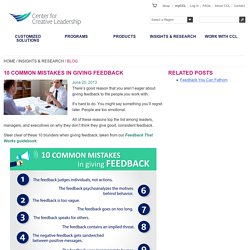

How Emotionally Intelligent People Give Negative Feedback. Stanford Social Innovation Review. Behavioral principles for delivering effective feedback. Having a workplace environment in which feedback is given and received productively is critical to performance, but it can be difficult to cultivate that culture.

Here's how behavioral tactics can help managers avoid missteps and deliver more effective feedback. Introduction In 2001, theatergoers flocked to see a movie that would eventually generate more than $550 million. It was about a 30-year-old accountant who is disillusioned by his job and life. But then one day, his mother sits him down and shares with him a book of his childhood drawings. Do you remember the movie? That’s not how you recall the story line though, is it? That is because this version of the movie was never made. Although most of us don’t have our sights set on producing the next blockbuster film, there are clear benefits to cultivating a workplace in which feedback is given and received in the productive manner described by Catmull. To address this delicate balance, we look to the behavioral sciences for guidance. The Simple Way to Give Difficult Feedback (Without Hurting Feelings)
Whether you're a leader or a peer, part of your responsibility is to give people feedback.

Having been raised in a culture that often dances around the truth and tiptoes near insecurities, you may lack the skills required to balance brutal honesty with a sense of compassion. Think about the feedback you've been given. Chances are, in some of those situations, the feedback was hurtful. Other times, after the initial sting subsided, you learned a great deal about yourself. In the best type of feedback, however, you felt respected, safe, and pushed slightly outside of your comfort zone. Finding that perfect mix is easier than you think. Here is the simple, five-step way to provide difficult feedback: 1. For feedback to be effective, it must be received. Challenge yourself to find something meaningful about the person's work or intention rather than making up something superficial. 2.
Check yourself. 3. Try taking a more objective approach and seeing the situation for what it is. 10 Common Mistakes in Giving Feedback. There’s good reason that you aren’t eager about giving feedback to the people you work with.

It’s hard to do. You might say something you’ll regret later. People are too emotional. All of these reasons top the list among leaders, managers, and executives on why they don’t think they give good, consistent feedback. Steer clear of these 10 blunders when giving feedback, taken from our Feedback That Works guidebook: Mistake #1: The feedback judges individuals, not actions. 3 Ways to Encourage Employees to Give You More Feedback. When you're the boss, bad news, unpleasant as it is, can be incredibly valuable... and incredibly hard to come by.

Without knowing what's going wrong in your business, you can't fix things, but employees are generally hesitant to be the bearers of bad news. And as Claire Lew, CEO of Know Your Company, pointed out on Signal v. Noise recently, they're often even more reluctant when they suspect that you might not exactly welcome this sort of negative feedback with open ears. "The biggest reason I didn't give my boss feedback is I believed that even if I did speak up, nothing would change. I believed my boss wouldn't do anything with my feedback. "Futility has been found to be 1.8 times more common than fear as a reason for employees not speaking up to their managers. So what's the remedy for this fear that negative feedback will simply be ignored?
Abraham Lincoln's Brilliant Method for Handling Setbacks. What was the secret of Abraham Lincoln's success in dealing with people?

Incredibly, this is not just a question that a business journalist would ask. Dale Carnegie himself--the legendary author of How to Win Friends and Influence People--asked the exact same question on page 8 of that famous book. Carnegie was in a unique position to know the answer. Four years before How to Win Friends came out, he authored a book called Lincoln the Unknown, which he spent three years working on. How Lincoln Practiced Patience The point is that Carnegie--America's preeminent expert on networking, arguably the person who first codified networking as a skill--analyzed Lincoln's life for his people skills. As an example, Carnegie cites a letter Lincoln wrote to a general who disobeyed his orders during the Civil War.
"I do not believe you appreciate the magnitude of the misfortune involved in Lee's escape. In One Step: How to Ensure Leadership Development Works. Understanding Feedback: The 'GPS Direction' To Leadership Success. Feedback is the Breakfast of Champions: 10 Tips for Doing it Right. Abraham Lincoln's Brilliant Method for Handling Setbacks.